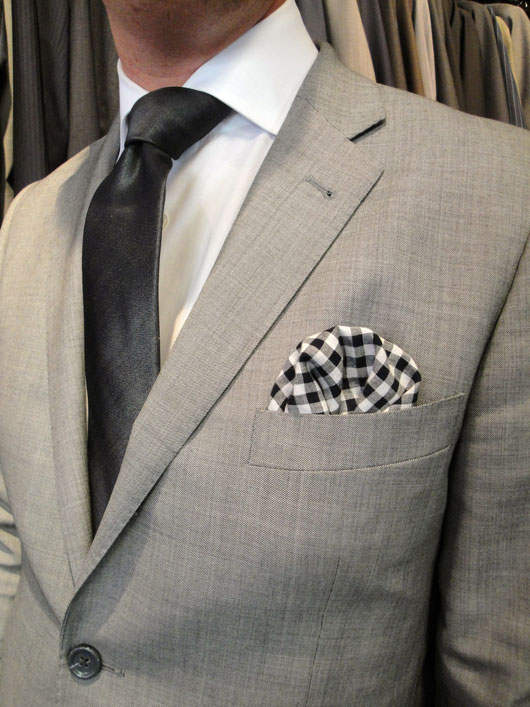No products in the cart.
Dressing and Grooming
Pocket Squares Part 1 – How to wear Pocket Squares
Pocket squares have got to be one of our favourite accessories on a suit. Not only are there a million ways (ok, that’s exaggerating, maybe about 9 ways or so) to wear them but they also come in a variety of colours, patterns and materials. They are small, affordable and add that pop to a suit without even trying. You could essentially wear the same suit once a week and make it look completely different by simply wearing a different pocket square.
How did Pocket Squares come about?
It is interesting to note that pocket squares, as fashionable and versatile as they are, went out of fashion. Yes, we know – hard to believe. Their origins can be traced back to the 16th century. Pocket squares were then known as handkerchiefs or kerchiefs. They still may be known as handkerchiefs but fashionably speaking, it brings the wrong images to mind. Pocket squares are meant to make your suit look good, handkerchiefs on the other hand could be used for a variety of purposes.
Infact, the main reason for the origin of the handkerchief (pocket square) was to wipe the forehead/nose. Some even claim that perfume was sprayed into the handkerchiefs by noble men who were trying to cover up the stench of the working classes as they travelled through town. Harsh. But then again, this could be useful on the tube 🙂 (Just kidding!)
This does not seem to be mentioned anywhere we have looked, but we are guessing that a handkerchief could have been useful, say you were in the right place at the right time, and a lady was in distress/spilled a drink at the bar. You could always lend your handkerchief to wipe her tears/help clean the spill. (They always do in Hollywood)
Rules regarding pocket squares:
So before we go any further, it may be worth stating a few rules with regards to pocket squares.
- You shall call a pocket square a pocket square and not a handkerchief if you want to sound fashionable. ( And if you don’t want to gross out others by bringing the wrong images to mind)
- You shall not blow your nose/ wipe your forehead using your pocket square. You have two pockets in your trousers (or more) for storing your so called handkerchiefs.
- You may but it would be better to lend your handkerchief to a lady in distress (rather than your pocket square) if you find one / a lady who has spilled her drink at the bar.. because.. well.. doesn’t fashion come first? Your suit would be screaming “Help! I’m naked” without a pocket square. So always keep a spare handkerchief, maybe two.
- You shall not wear a suit without a pocket square because your suit will look dry without one.
- You shall make sure you match your tie and pocket square just right. Please read below for more style advice.
- Your pocket square must be clean. This is a no-brainer.
- You shall start with a few plain colours if you are a novice. These tend to match most suits.
- You shall not wear your pocket square on your head, even if it is raining and you are living in London. Carry an umbrella. (Incase you are wondering why this rule is here, the handkerchiefs were originally head scarves. Also, desperate times call for desperate measures.)
How to wear pocket squares?
We would have created a comprehensive list of different ways of wearing pocket squares, but this has already been done superbly by www.realmenrealstyle.com, that we will just have to share their infographic.
Check out these 9 ways of wearing your pocket square.
What materials are pocket squares made of?
Pocket squares can be comprised of silk, linen, cotton or even satin.
Which material to buy would depend mainly on how you intend to wear it (there are several ways of wearing pocket squares), where you intend to wear it (work, party) or even simply which material you prefer.
Silk:
Silk seems to be the most popular pocket square material that is sold in stores. It could be because it exudes luxury, however, it is worth noting that it is difficult to wear a silk pocket square. There are several ways to wear a pocket square which require folding, and due to the softness of silk, it would fail to maintain that shape. Silk pocket squares can be worn easily using the “puff” style, where the pocket square doesn’t need to be folded. (Also, silk is a great idea if you are lazy – who can be bothered with folding, right?)
Silk pocket squares have a sheen to them that make them look luxurious. They are great for a party or casual event. These days men are fashionably adventurous, and may still wear silk pocket squares to up their dapper game. If you are an entrepreneur/businessman, there is no reason for you not to wear these – heck you can do whatever you wish, wear what ever you want, who’s going to stop you? However, if you are working for someone else, best to observe what everyone else is wearing!
Silk pocket squares would look great with a woolen suit and silk tie.
Cotton:
Cotton is a very rigid material and would be easy to fold. There are a multitude of ways to fold pocket squares that actually fold, therefore, you would be able to wear your cotton pocket square differently, every time you wear it, creating a different look every time. Cotton is also a cheap alternative and affordable.
Given the rigidness of cotton, it is likely to draw attention to your suit and give it that strong and geometrical look. A cotton pocket square would be great for office and business meetings.
Linen:
Linen pocket squares take the middle ground. They are more rigid than silk but softer than cotton. You would most likely be able to wear the pocket square in all the different ways using linen pocket squares.
Linen pocket squares would look great both at office and casually. They may not have the elegance of silk though if you are looking to go to a lush party.
Finally, we have heard that the way in which you wear your pocket square reflects your personality (the material may have a hand in this), so style it in a certain way at your own risk 😉
Pocket square patterns and colours
Pocket squares also come in a variety of colours and patterns, which doesn’t come as a surprise.
Plain pocket squares:
When you first start out wearing a pocket square, it is probably best to start with a plain colour while you learn the tricks of the dapper game. Plain white is the holy communion. You can never go wrong with white. It would match any suit, tie and you don’t have to worry about patterns.
Grey pocket squares are also quite neutral and would most likely go with most suits. As you go along, you may buy various colours depending on what you will be matching it with eg your tie, your shirt, your blazer etc.
Once you become more adventurous, you’ll find that bright bold colours look great on darker suits eg an orange/yellow pocket square will add pop to your black suit.
Patterned pocket squares:
Patterned pocket squares come in paisley, polka dots, checks and stripes. Our favourite pattern out of these is Paisley because there is a certain sort of elegance and richness to it.
Paisely pocket square

Polka Dot pocket square

Checked pocket square

Buying tips:
Endeavour to buy a pocket square with hand-rolled edges. They may be more expensive but given that your pocket square will draw a lot of attention to it, you should make sure it is of a good quality. Hand-rolled edge pocket squares are stitched by hand to have a clean finished look, where as machine-sewn pocket square edges will have several exposed loose threads.

We hope you enjoyed reading our guide on how to wear pocket squares. We will be introducing a part 2, which will show you how to style pocket squares with your suit, tie and blazer etc. So feel free to keep reading our blog and we would love to hear your comments, suggestions and feedback!

